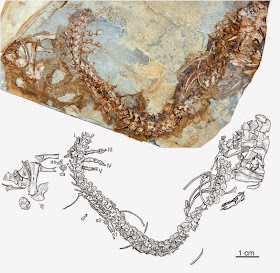Synapsids, the group which gave rise to and includes the modern Mammals (and which are sometimes misleadingly known as ‘Mammal-like Reptiles’) diverged from the other early Amniotes (fully terrestrial Vertebrates) about 315 million years ago in the Late Carboniferous, and went on to become the dominant large vertebrates in Permian ecosystems, though they suffered badly in the end-Permian extinction, and were replaced as dominant large animals in Mesozoic terrestrial ecosystems by the Archosaurs.
Within the early Synapsids two groups became specialized herbivores, the first terrestrial Vertebrates to adopt this lifestyle, developing many of the traits see in other Tetrapod groups that adapted to herbivorey later in the history of the group. One of these groups, the Caseids, are thought, based upon their morphology, to have been the first group to diverge from other Synapsids, though their origins are somewhat obscure. The earliest known members of the group are small herbivores from upland regions (always underrepresented in the fossil record) from the latest Early Permian of Oklahoma and Germany, with larger forms appearing more widely in the fossil record later in the period.
In a paper published in the journal PLoS One on 16 April 2014, Robert Reisz of the Department of Biology at the University of Toronto Mississauga and Jörg Fröbisch of the Museum für Naturkunde at the Leibniz-Institut für Evolutions- und Biodiversitätsforschung and the Institut für Biologie, Humboldt-Universität zu Berlin describe a new species of Caseid Synapsis from the Late Pennsylvanian (Late Cretaceous) Calhoun Shale at Hamilton Quarry in Greenwood County, Kansas. The Hamilton Quarry locality is considered to be a fossil lagerstätte, and has produced a large number of well preserved remains of Acanthodian Fish and Dissorophoid Amphibians, as well as the earliest or very early members of several terrestrial Vertebrate groups.
The new Caseid Synapsid is named Eocasea martini, where ‘Eocasea’ means ‘dawn-Caseid’, a reference to the specimen’s status as the earliest known member of the group, and ‘martini’ honours the late Larry Martin of the Dyke Museum of Natural History at the University of Kansas, who discovered and excavated the specimen from which the species is described. This is the earliest known member of the group, predating the next known fossil by about 25 million years, and is the first Caseid known from before the Permian.
Eocasea martini. Photograph and interpretive drawing of single known specimen, from the late Pennsylvanian of Kansas, USA. Preserved parts of the skeleton include the posterior 1/3rd of the skull and mandible, the vertebral column with ribs, pelvic girdle and right hind limb. Abbreviations: as, astragalus; ca, calcaneum; f, femur; fi, fibula; il, ilium; is, ischium; pu, pubis; s1, first sacral rib; s2, second sacral rib; t, tibia; roman numerals indicate the digit number in the pes. Reiz & Fröbisch (2014).
The specimen comprises the right mandible and rear third of the skull, as well as most of the vertebral column, the pelvic girdle and most of the right hind limb. The remains come from a juvenile animal about 125 mm in length, which would probably have weighed considerably under 10 kg when fully grown, making it the smallest known member of the group as well as the earliest.
Eocasea martini shows no adaptations to herbivorey, and is thought to have been entirely carnivorous in diet. This suggests that like other large, herbivorous Tetrapods, the Caseids originated from small carnivores, becoming large in size after adopting a diet of vegetation, something almost certainly connected to the need to develop an elongated gut to deal with a herbivorous diet.
See also…
 A Eutherian Mammal from the Late Cretaceous of Kazakhstan.
A Eutherian Mammal from the Late Cretaceous of Kazakhstan. A Eutherian Mammal from the Jurassic of China.
A Eutherian Mammal from the Jurassic of China.
Follow Sciency Thoughts on Facebook.


